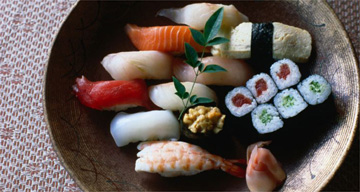
In Tokyo, I feel like a big, crude, ugly, hairy fool. Especially at table. The delicate, aesthetic approach to eating here both fascinates and fills me with fear of the faux pas. The designer Machiko Jinto is willing to overlook my scarce social graces, and takes me to dinner in Roppongi. We duck into Kanda's restaurant, and crouch along a corridor that opens into a quietly white room accessorised by a single stem of cherry blossom and a smiling waitress.
The restaurant comprises eight comfortable bar stools along a counter, on the other side of which works chef Kanda and his assistant. A meal follows which melds perfectly the elements of flavour, taste, temperature, texture and beauty which so define Japanese food. Kanda offers us a choice of sake cups. Each has its own shape, shade, glaze and size: all are thrown by the same potter who makes all Kanda's crockery.
We choose a sake, which comes slightly chilled. Chef bows, sharpens each of his knives very carefully on a whetstone, and dinner is served. First, early spring greens, with a cool paste of whipped tofu and toasted sesame. Rockfish next, with dabs of fresh sour plum sauce and coriander stems. Each serving plate is different and amplifies Kanda's exquisite presentation. Hardly seared cherry trout the colour of cornelian comes on a square-ish platter of blush pink and pale pistachio, with a tiny volcano of fresh-grated wasabi, and a soy sauce that's double fermented and has the texture of silk.
It's time for a new sake (and new sake cups). We choose Kajikoma, which means running horse. It has a retsina hue and tastes faintly of anis. A lacquer bowl with a bamboo motif covers another of steaming soup.
If you knew sushi like the one Kanda serves next, you'd never touch the factory stuff again. There is toro - fatty tuna - with wasabi-scented soy and just-warm moist rice, then golden sea bream. Before slicing each fish, Kanda wipes his knife - with fresh lime for the dorade, yuzu (japanese tangerine) for the toro. This adds a suspicion of flavour, and tantalises the palate.
By now, we're swimming in sake and admiration for chef Kanda, who is greatly enjoying our enjoyment. He serves a slim slice of chicken. It is accented with angelica, a bitter herb over the sweet meat. This is followed by a shred of grilled chicken. More sake - this time Golden Pride, which is decanted into a svelte pinched pouring jug ... then a jelly of chilled bonito dashi stock with mirin (rice cooking wine), dusted with white poppy seeds.
Kanda celebrates spring energy with a soup of scallops, in which I find a bite of fugu, the (potentially fatal) blowfish. I try to find a way to say that dinner is slaying me. And fail. The fugu is spiced with powdered sancho mountain pepper. No Japanese meal feels complete without rice, and ours is perfectly bland, albeit lifted with sweetly crunchy pickles and sesame-strewn daikon radish. We finish with roasted hojicha tea, and strawberries and milk ice cream.
Kanda has no TV show, no cookbook, no celebrity endorsements. In terms of subtlety, rhythm, elegance, art, attention to detail and sheer pleasure quotient, chef Kanda exceeds the puny efforts of those British culinary Lilliputians who are also big, crude, ugly, hairy fools. He bows, presents the modest bill, and is too polite to say, of course, that there's no "f" in class.
· Kanda, Kamu Motoazabo, Minato-Ku (0081 3 5786 0150). Menus and price at the chef's discretion; around £70 per head, including sake. Ffestiniog Travel (01766 512400, festtravel.co.uk) arranges tailor-made holidays to Japan.

